
In the realms of IT, with each passing day, new technologies and practices are emerging which change the shape of today’s society. One of the most intriguing and highly promising areas is generative artificial intelligence (generative AI), bringing the awesome ability to create, build and turn information into reality. Here we’ll break down what generative AI exactly is and what tools are already available.

What is Generative AI?
This specific type of AI is quite an innovative field which has become particularly active in recent years. Generative AI focuses on creating new data, content, and resources by mimicking a writing style and personality traits that are similar to those produced by the human.
A fundamental principle of Generative AI is to produce data by means of a variety of algorithms and models such as generative adversarial networks (GANs), autoencoders, variational autoencoders, and so forth. However, GANs developed by Ian Goodfellow in 2014, have become one of the most prominent and successful models for content generation.

The functioning of GAN involves the cooperation of two neural networks: a generator and a discriminator. The generator creates fake data (e.g., images, sounds, or text), whereas the discriminator attempts to distinguish this fake data from real one. During the learning process, the generator gradually improves its skills to make the generated data more and more true-to-life, while the discriminator becomes more proficient in recognizing differences.
Generative AI uses span multiple domains. When it comes to the arts and creative industry in general, such AI is used to create unique pieces of artwork, generate music, artistic images, and even to develop new designs. Generative AI can also be seen in genomics, chemistry and pharmaceuticals, where it can help create new drugs and study complex biological systems.
Beyond its stunning opportunities, however, generative AI also raises certain ethical and social issues. For example, how can we identify the authorship of a work if it is created through AI? What restrictions should be imposed on the use of generative AI so that the authenticity of the artwork is not compromised? The ability to create fake content that goes against the concept of truthfulness and credibility stirs up concerns in the field of information security and fake news.
History and evolution
Generative AI has come a long way in its development, starting from its inception to its continuous development nowadays. This technology has undergone a series of breakthroughs and shifts, expanding its capabilities and use cases.
Early steps in the field were made back in the 1950s and 1960s, as researchers began experimenting with algorithms that could perform through simple patterns. Nevertheless, at that time, the limited computing power and data availability did not yield significant results.
As computer technology advanced in the 1980s and 1990s, the first prototypes of generative algorithms emerged to create more complex entities such as images and music. Still, most of these systems were quite limited and could not provide a high degree of realism.
What made an imminent leap forward in the development of generative AI was the advent of deep learning and GANs in 2014. This was revolutionary at a time, as GANs allowed neural networks could be trained to produce high-quality and lifelike data hard to differentiate from that generated by humans. Generative AI could now create photorealistic images, music, and even texts, causing people to gasp in wonder and admiration.

Over recent years, generative AI has been extensively applied in various domains. In medicine, they are used to generate images of bioartificial organs, simulate radiotherapy and improve diagnostic techniques. Within the creative industry, it helps artists and designers create exceptional works and simplifies the development process for computer games and virtual reality.
The progression of generative AI continues, with the technology only growing more astonishing and powerful with each passing day. With its potential to bring groundbreaking changes to various industries is undeniable and its advancement will keep inspiring us to reach new heights of creativity and innovation.
What’s happening with Generative AI today?
At present, Generative AI is booming and is one of the most compelling and prospective areas of artificial intelligence. This technology continues to dazzle us with its abilities and finds a wide spectrum of applications in various spheres of life and business.
Among the most notable areas where generative AI is already demonstrating tremendous results is content generation. Generative AI models have the power to create photorealistic images, unique tunes, lyrics, as well as produce immersive scenes and objects for computer games and VR. This greatly streamlines the content development process, resulting in faster and more efficient creation of top-grade products.
Generative AI has also been actively employed in the field of artificial modeling and simulation. In the automotive industry, this type of AI is being used to optimize car design and create more efficient and safer vehicle components.
Yet another area where Generative AI is proving its strength is in data processing and analysis. Here these models are capable of generating realistic data from the available ones, thus being useful in training neural networks on insufficient data or improving machine learning algorithms.
Conclusion
Since its arrival, generative AI has gone a long journey, from the first experiments in the last mid-century to the revolution that occurred with the advent of generative-adversarial networks in 2014. This milestone has opened up new possibilities for creating photorealistic images, music, text, and other content that exceeds expectations and encourages creative people to break new ground.
Generative AI is gaining adoption in a variety of fields including art, medicine, automotive and many others. It speeds up media content creation, improves diagnostics and simulation processes in medicine, and helps optimize various production processes in other industries.
